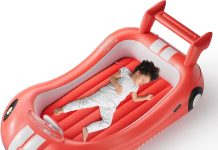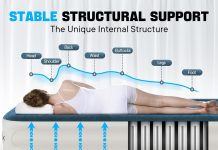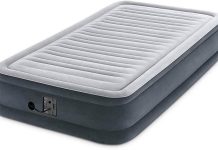Did you ever wonder what to do with your old air mattress once it has outlived its usefulness? We all know that recycling is important for the environment, but can you actually recycle old air mattresses? In this article, we explore the options available for recycling these bulky items and how you can give them a new lease on life. Stay tuned to find out how you can contribute to a greener planet by responsibly disposing of your old air mattresses!
Review contents
Why Recycling Air Mattresses is Important
Reducing Waste and Landfill Space
Recycling air mattresses is essential for reducing waste and conserving landfill space. As consumerism continues to grow, so does the amount of waste we generate. Air mattresses, like any other product, eventually reach the end of their lifespan and are discarded. If not properly recycled, these mattresses end up taking up valuable space in landfills, where they can take decades to decompose. By recycling air mattresses, we can significantly reduce the amount of waste sent to landfills and help create a more sustainable future.
Conserving Natural Resources
Air mattresses are made from various materials, including plastics, textiles, and metals. The production of these materials requires significant amounts of natural resources, such as petroleum and water. By recycling air mattresses, we can recover and reuse these resources, reducing the need for extracting virgin materials. This conservation of natural resources is crucial for preserving our environment and minimizing the impact of resource extraction on ecosystems.
Decreasing Pollution
The improper disposal of air mattresses contributes to pollution in various ways. When air mattresses end up in landfills, the breakdown of their components can release harmful chemicals into the soil and groundwater. Additionally, if air mattresses are incinerated or disposed of inappropriately, they can release toxic fumes and pollutants into the air. However, by recycling air mattresses and properly managing their disposal, we can mitigate pollution and protect the quality of our environment.
Understanding the Components of an Air Mattress
Polyvinyl Chloride (PVC)
One of the primary components of air mattresses is polyvinyl chloride (PVC), a type of plastic known for its durability and flexibility. PVC is commonly used in air mattresses due to its resistance to punctures and ability to retain air. However, PVC is not biodegradable and can have adverse effects on the environment if not properly recycled. By recycling PVC from air mattresses, we can prevent the release of harmful toxins and reduce the reliance on virgin PVC production.
Textiles and Fabrics
Air mattresses usually feature textiles and fabrics for comfort and support. These materials can include polyester, nylon, and cotton. These textiles can be recycled into new products or repurposed for alternative uses. Recycling textiles not only reduces waste but also conserves energy and reduces the environmental impact of textile production, which involves various chemicals and water-intensive processes.
Metal and Plastic Components
In addition to PVC and textiles, air mattresses may also contain metal and plastic components. Metal elements, such as springs or connectors, are often found in more traditional air mattresses that mimic the structure of traditional mattresses. Plastic components, such as valves or pumps, are commonly used in inflatable air mattresses. These metal and plastic components can be salvaged through recycling processes, ensuring that valuable materials are recovered and reused.
Challenges in Recycling Air Mattresses
Mixed Materials
One of the major challenges in recycling air mattresses is dealing with the mixed materials they contain. Air mattresses often consist of a combination of PVC, textiles, and metal or plastic components. Separating these materials can be a complex and time-consuming task, as they are interconnected and may require specialized recycling processes. However, advances in recycling technology are helping to overcome these challenges, making it increasingly feasible to recycle air mattresses effectively.
Contamination
Contamination is another obstacle in the recycling of air mattresses. During their use, air mattresses can become soiled or stained, rendering them unsuitable for recycling without proper cleaning. Additionally, if air mattresses are improperly disposed of, they may come into contact with other waste materials, further contributing to contamination. Therefore, it is crucial to ensure that air mattresses are cleaned and separated from other waste before initiating the recycling process.
Size and Bulkiness
Air mattresses, especially larger ones, can be quite large and bulky, making them difficult to transport and store. This size and bulkiness present challenges for recycling facilities that may have limited space or specialized equipment. However, these obstacles are not insurmountable. By collaborating with recycling centers and utilizing transportation and storage solutions specifically designed for larger items, we can overcome the challenges related to the size and bulk of air mattresses.
Recycling Options for Air Mattresses
Check Local Recycling Programs
The first step in recycling an air mattress is to check for local recycling programs that accept these items. Many municipalities and waste management facilities have established recycling programs specifically for mattresses and bedding. These programs may have designated drop-off locations or offer curbside collection services. By taking advantage of these local recycling programs, we can ensure that our air mattresses are properly recycled and diverted from landfills.
Contact Mattress Retailers
Another option for recycling air mattresses is to contact mattress retailers directly. Some mattress retailers have their own recycling programs or have partnered with recycling facilities to accept old mattresses, including air mattresses. These retailers often offer incentives, such as discount coupons on the purchase of a new mattress, to encourage customers to recycle their old mattresses. By reaching out to mattress retailers, we can learn about their recycling options and contribute to a more sustainable mattress industry.
Reusing or Repurposing
If recycling options are limited or unavailable in your area, consider reusing or repurposing your old air mattress. Depending on its condition and materials, an air mattress can have various secondary uses. For example, it can be used as temporary bedding for guests, converted into a comfortable outdoor lounger, or repurposed as cushioning material for DIY projects. By finding creative ways to reuse or repurpose our old air mattresses, we can extend their lifespan and minimize waste.
Step-by-Step Guide to Recycling an Air Mattress
Check for Recycling Symbols
Before recycling an air mattress, it is important to check for recycling symbols or labels on the product. These symbols indicate that the air mattress is made from recyclable materials or that it has been manufactured using sustainable practices. If the air mattress has recycling symbols, follow the specific instructions provided to ensure proper recycling. If no recycling symbols are present, proceed with general recycling guidelines for the materials that make up the air mattress.
Deflate and Disassemble the Mattress
Once you have determined that your air mattress is recyclable, the next step is to deflate and disassemble it. Start by releasing the air from the mattress, either by using the built-in valve or manually deflating it. Once fully deflated, remove any accessories, such as pumps or pillows, and set them aside for separate recycling or reuse. Disassemble the mattress by separating the different components, such as the PVC body, textiles, and metal or plastic elements.
Separate and Sort Components
After disassembling the air mattress, separate and sort the components according to their materials. Place the PVC body in a designated PVC recycling container. Textiles, such as fabric covers or mattress toppers, can be collected for textile recycling or repurposing. Metal components, such as springs or connectors, should be gathered and taken to a metal recycling facility. Lastly, plastic elements, including valves and pumps, should be prepared for plastic recycling or reused if possible.
Recycling Other Related Items
Pillows and Cushions
In addition to air mattresses, it is important to consider the recycling options for related items, such as pillows and cushions. Like air mattresses, pillows and cushions may contain materials like foam, textiles, and plastics. While recycling options for pillows and cushions can vary depending on the materials they contain, some recycling facilities accept them. Additionally, certain charity organizations may accept clean and usable pillows and cushions for donation. It is essential to inquire locally to determine the best recycling or donation option for these items.
Inflatable Toys and Pool Floats
Many inflatable toys and pool floats are made from similar materials as air mattresses, including PVC and textiles. While recycling options for inflatable toys and pool floats may be limited, it is still worth exploring local recycling programs or contacting manufacturers and retailers for guidance. If recycling is not feasible, consider reusing or repurposing these items whenever possible. Repairing punctures or donating gently used inflatable toys and pool floats can help extend their lifespan and minimize waste.
Air Mattress Accessories
In addition to the air mattress itself, recycling options should also be considered for its accessories. Accessories such as air pumps, storage bags, and repair kits may contain plastics, metals, or other recyclable materials. Ensure that these accessories are properly separated and sorted before recycling, following the same guidelines applicable to each material. If recycling options are limited, consider reusing or donating these accessories to prolong their usefulness and reduce overall waste.
Benefits of Properly Recycling Air Mattresses
Conservation of Resources
Properly recycling air mattresses contributes to the conservation of valuable resources. By recovering materials such as PVC, textiles, and metals through recycling processes, we can reduce the demand for virgin materials extraction. This conservation of resources helps minimize the environmental impact associated with raw material production, including energy consumption, water usage, and greenhouse gas emissions. Recycling air mattresses is a meaningful step toward achieving a more sustainable and resource-efficient future.
Reduction of Greenhouse Gas Emissions
Recycling air mattresses plays a significant role in reducing greenhouse gas emissions. When air mattresses are sent to landfills, they decompose over time, producing methane gas, a potent contributor to climate change. By recycling air mattresses and diverting them from landfills, we can prevent the release of these harmful greenhouse gases. Additionally, recycling processes generally require less energy compared to producing new materials, further reducing carbon dioxide emissions associated with manufacturing.
Promoting Circular Economy
Recycling air mattresses is an essential element of a circular economy. Instead of following a linear model of production, consumption, and disposal, a circular economy aims to create a closed-loop system in which materials are continuously reused and recycled. By incorporating recycled materials from air mattresses into the production of new products, we support the creation of a sustainable and circular economy. Recycling air mattresses is not only an environmental responsibility but also a way to foster economic growth and innovation.
Innovations in Air Mattress Recycling
Mattress-to-Mattress Recycling
Innovations in air mattress recycling have led to exciting developments in the industry. One notable innovation is mattress-to-mattress recycling, where old air mattresses are processed and transformed into new mattresses. By using advanced recycling techniques and technologies, manufacturers can extract valuable materials, such as PVC and textiles, from old air mattresses and incorporate them into the production of new mattresses. This approach helps close the recycling loop and reduces the need for virgin materials in mattress manufacturing.
Material Recovery for New Products
Another innovative approach in air mattress recycling is material recovery for new products. In this process, various materials from recycled air mattresses are recovered and repurposed for the production of alternative products. For example, PVC can be transformed into new plastic products, textiles can be used for insulation or upholstery, and metal elements can be melted down and reused in various industries. Material recovery not only reduces waste but also creates opportunities for new, sustainable product development.
Conversion to Alternative Fuels
In some cases, air mattresses that cannot be effectively recycled through traditional methods can be converted into alternative fuels. This process, known as energy recovery or waste-to-energy, involves combusting the mattress in specialized facilities to generate heat or electricity. While energy recovery should be considered a last resort after recycling and material recovery, it still provides a more sustainable alternative to landfill disposal. Converting air mattresses into alternative fuels helps minimize landfill reliance and reduces the demand for fossil fuel-based energy sources.
Where to Donate Old Air Mattresses
Homeless Shelters and Charities
When an air mattress is still in usable condition, donating it to homeless shelters and charities is a wonderful option. These organizations often provide temporary housing and support to individuals and families in need. Many homeless shelters accept donations of clean and gently used air mattresses to assist those seeking temporary shelter or transitioning to more permanent housing. By donating your old air mattress, you can directly help individuals and families in your community and contribute to their comfort and well-being.
Animal Shelters and Rescues
Animal shelters and rescues are another excellent option for donating old air mattresses. Many shelters use air mattresses as comfortable bedding for animals in their care. Donating your old air mattress to an animal shelter or rescue organization can provide a cozy and supportive resting place for animals awaiting adoption. Before donating, ensure that the air mattress is clean, free of damage, and suitable for the specific needs of the shelter or rescue.
Environmental and Recycling Organizations
Some environmental and recycling organizations may accept old air mattresses for donation or recycling. These organizations often have programs in place to refurbish or recycle mattresses as part of their broader mission to promote sustainability and waste reduction. Contact local environmental or recycling organizations to inquire about their specific requirements for air mattress donations. By donating to these organizations, you can support their initiatives and contribute to a greener future.
Conclusion
The Importance of Recycling Air Mattresses
Recycling air mattresses is crucial for reducing waste, conserving natural resources, and minimizing pollution. By recycling the various components of air mattresses, such as PVC, textiles, and metal or plastic elements, we can prevent valuable materials from ending up in landfills and reduce reliance on virgin resource extraction. Additionally, recycling air mattresses helps decrease pollution, including toxic chemical release, and contributes to a healthier environment for both humans and wildlife.
Individual Responsibility in Waste Management
As consumers, it is important to recognize our individual responsibility in waste management. Properly recycling air mattresses and related items, such as pillows and inflatable toys, demonstrates our commitment to sustainable practices and supports the development of a circular economy. By following local recycling guidelines, contacting mattress retailers, and exploring donation options, we can play an active role in reducing waste and promoting environmental stewardship. Together, we can make a significant impact in preserving our planet for future generations.






























